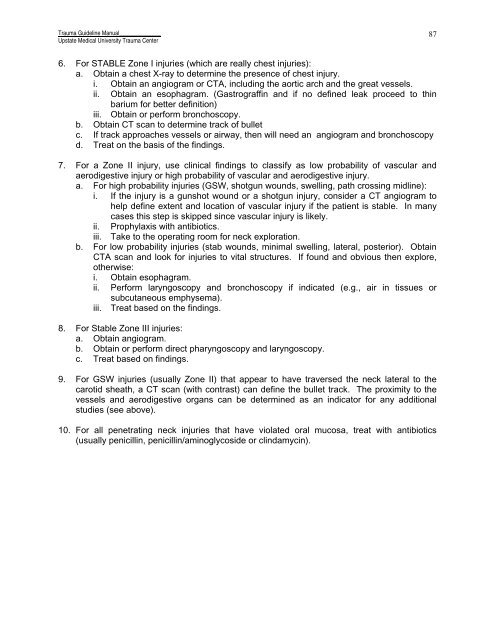Trauma Guideline Manual - SUNY Upstate Medical University
Trauma Guideline Manual - SUNY Upstate Medical University
Trauma Guideline Manual - SUNY Upstate Medical University
You also want an ePaper? Increase the reach of your titles
YUMPU automatically turns print PDFs into web optimized ePapers that Google loves.
<strong>Trauma</strong> <strong>Guideline</strong> <strong>Manual</strong>______________<strong>Upstate</strong> <strong>Medical</strong> <strong>University</strong> <strong>Trauma</strong> Center876. For STABLE Zone I injuries (which are really chest injuries):a. Obtain a chest X-ray to determine the presence of chest injury.i. Obtain an angiogram or CTA, including the aortic arch and the great vessels.ii.Obtain an esophagram. (Gastrograffin and if no defined leak proceed to thinbarium for better definition)iii. Obtain or perform bronchoscopy.b. Obtain CT scan to determine track of bulletc. If track approaches vessels or airway, then will need an angiogram and bronchoscopyd. Treat on the basis of the findings.7. For a Zone II injury, use clinical findings to classify as low probability of vascular andaerodigestive injury or high probability of vascular and aerodigestive injury.a. For high probability injuries (GSW, shotgun wounds, swelling, path crossing midline):i. If the injury is a gunshot wound or a shotgun injury, consider a CT angiogram tohelp define extent and location of vascular injury if the patient is stable. In manycases this step is skipped since vascular injury is likely.ii. Prophylaxis with antibiotics.iii. Take to the operating room for neck exploration.b. For low probability injuries (stab wounds, minimal swelling, lateral, posterior). ObtainCTA scan and look for injuries to vital structures. If found and obvious then explore,otherwise:i. Obtain esophagram.ii. Perform laryngoscopy and bronchoscopy if indicated (e.g., air in tissues orsubcutaneous emphysema).iii. Treat based on the findings.8. For Stable Zone III injuries:a. Obtain angiogram.b. Obtain or perform direct pharyngoscopy and laryngoscopy.c. Treat based on findings.9. For GSW injuries (usually Zone II) that appear to have traversed the neck lateral to thecarotid sheath, a CT scan (with contrast) can define the bullet track. The proximity to thevessels and aerodigestive organs can be determined as an indicator for any additionalstudies (see above).10. For all penetrating neck injuries that have violated oral mucosa, treat with antibiotics(usually penicillin, penicillin/aminoglycoside or clindamycin).
















